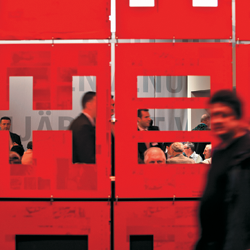 Great question! I wish the answer were as simple as ticking boxes on a checklist. But think about the wide range of Green priorities exhibitors bring to the table – everything from toxics to carbon to environmental justice to buying local. You can see how hard it would be to define "Green" with a single word.
Great question! I wish the answer were as simple as ticking boxes on a checklist. But think about the wide range of Green priorities exhibitors bring to the table – everything from toxics to carbon to environmental justice to buying local. You can see how hard it would be to define "Green" with a single word.
On top of this, local factors come into play. Take electricity for example. Builders in some states are free to buy renewable power from Green energy providers, but in California, they can't. Californians must buy power from their local utility companies. The utilities make up for this by investing in renewable energy and subsidizing energy efficiency upgrades that builders in other states would have to buy at market rates.
In other regions, such as the Chicago area, companies can negotiate favorable pricing from their utility companies. Simple economics tend to trump Green goodwill in these locales.
You're not dealing with apples-to-apples comparisons, so you need to look below the surface. A good way to do this is by asking a lot of questions about a few key indicators.
Look Outside
Start in the parking lot. Many businesses provide cars as perks to executives and sales staff. What are people driving? Is the company offering fuel-efficient cars or passing out SUVs? Be sure to ask, because you might not be able to tell which cars the company owns.
Look Up
Lighting can be an energy hog, and technology makes a big difference. Does the facility put daylight to use? Have incandescent lamps been upgraded to CFLs or LEDs? Have light switches been replaced with daylight sensors or motion detectors?
Again, ask questions. One builder negotiated such a low rate for electricity that it made no sense to upgrade his lighting systems. He spends his upgrade money elsewhere.
Heating, air conditioning, and ventilation (HVAC) tend to be out of sight and out of mind until people start paying bills. One Midwestern shop owner spends $20,000 per month to heat the facility in wintertime – talk about an upgrade incentive! New technologies, such as huge, slow-speed ceiling fans, are beginning to save money and energy in factories.
Look Around
When the Exhibit Designers & Producers Association launched the Zero Waste Challenge Design/Build Competition last year, they focused on materials choices and how companies reduce landfill waste. Unless you can see racks of Green materials or scrap bins labeled for recycling, you'll have to ask about these practices.
While you are at it, ask what types of paints and adhesives the shop uses. A shop might choose Green materials for a special project here or there, but the factory will be equipped to run either toxic, solvent-based or less-toxic, water-based paints and adhesives every single day. Ask about their choices.
Look at Proposals
What materials do the shops specify in their bids? Do they offer flooring, lumber, metal, and graphic materials that include recycled content? Do they find ways to reuse and repurpose properties? Do they specify Energy Star equipment? Do they use SmartWay shippers? In other words, is sustainability part of the operating culture, or are they hyping one or two Green ideas to pacify your interest?
Trust your Gut
Remember that builders are running businesses. Going Green means picking sustainable options that meet all of the usual criteria for reliability, high quality, and cost-effectiveness. Solutions that seem ubiquitous in some cities might be cost prohibitive, impractical, or simply unavailable in others.
In the end, you are looking for a partner on the Green path. I've worked with builders who measure every material and process, and others who are outright skeptics. Both have delivered Greener exhibits because they were willing to experiment. Perhaps that's what the interview process is really all about: finding a builder who will join you in finding your way along the path.




 When builders learn we are interested in sustainability, they all say they're Green. How can we tell Green from Greenwashing?
When builders learn we are interested in sustainability, they all say they're Green. How can we tell Green from Greenwashing? Great question! I wish the answer were as simple as ticking boxes on a checklist. But think about the wide range of Green priorities exhibitors bring to the table – everything from toxics to carbon to environmental justice to buying local. You can see how hard it would be to define "Green" with a single word.
Great question! I wish the answer were as simple as ticking boxes on a checklist. But think about the wide range of Green priorities exhibitors bring to the table – everything from toxics to carbon to environmental justice to buying local. You can see how hard it would be to define "Green" with a single word.



